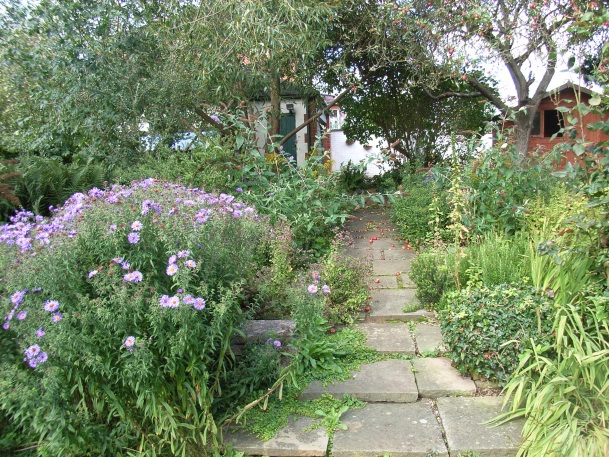- Home
- Garden Science
- Garden Biodiversity
- How many species live in gardens?
- Home
- Garden Science
- Garden Biodiversity
- How many species live in gardens?
How many species live in gardens?
We now know that ordinary gardens are extremely rich in species. This may seem odd, because most gardens are small and highly managed, and we also only see about 40 species of birds in gardens (6.7% out of 596 species on the British list).
The biodiversity in gardens lies in the invertebrates, the insects, molluscs and other animals without backbones. Until quite recently, ecologists were unaware of this. In 1966, one of the great founders of modern ecology, Charles Elton wrote:
“Broadly speaking the Domestic habitats (buildings and gardens) are in the direction of biological deserts, or at any rate very unnatural surroundings, though this fact is a bit concealed by the multitude of exotic plant species that inhabit our gardens and parks, yet have so few animals attached to them.” Charles Elton 1966 The Pattern of Animal Communities. Methuen, London. pp77-78 |
The embarrassing truth is that no-one had ever looked seriously at garden wildlife, so of course few species had been recorded. This changed when Dr Jennifer Owen described her studies in her quite ordinary Leicester garden. Learn more about the remarkable story of her work and how it has been validated and extended, in Ken Thompson’s leaflet on Jennifer Owen's studies
Over a 30-yr period, Owen recorded 2,673 species: 474 plants, 1,997 insects and 138 other invertebrates. The broad breakdown by group is shown in the leaflet Number of species recorded by Dr Jennifer Owen.
Owen's modest garden proved host to between 1% and 50% of all the known British species depending the group, averaging 9%. For native plants, the figure was 11%. And this extraordinary richness was found within an area only 741m², only 0.00000032% of the area of Britain.

View of Jennifer Owen's Leicester Garden - very attractive, but not managed especially for wildlife benefit.
Over 8,000 species?
The total only included the invertebrate groups Owen could sample and identify. Adding in the many groups (such as most flies and soil creatures) she couldn’t study, and assuming a similar proportion of the British species of these groups live in gardens, she arrived at a best estimate of 8,450 species of insects in her garden. She also presented evidence that the great majority of the animals she found were feeding in the garden, and that, depending on the group, between 20% to all of them were resident breeders. As Ken Thompson’s account shows, later work in Sheffield and several other cities has broadly confirmed Jennifer Owens findings.
Owen’s remarkable total is primarily a tribute to the intensity of her collecting and observation in one place over a long period. Few nature reserves have remotely such comprehensive lists, and a thirty year study in some could yield comparable diversity. Nevertheless, her work, backed up by later studies, shows a single garden can hold exceptional biodiversity in a tiny area.
Countryside comparisons
The flies of Malham Tarn National Nature Reserve in North Yorkshire have been subject to intensive scrutiny for decades, and the total list is far in excess of the number of species recorded in Owen’s garden. Partly that’s because the garden is much smaller, and partly because only one family of flies (hoverflies) has been studied intensively in the garden.
Remarkably, more species of hoverflies have been recorded in Owen's garden than in the nature reserve. Does that mean Owen’s garden is in any sense ‘better’ than the nature reserve? No, it doesn’t, but it does illustrate just how good gardens can be for groups of animals that find the habitat particularly suitable for them.
How do gardens sustain great biodiversity?
Jennifer Owen considered this question, and came up with some answers that still seem reasonable. In summary, we can suggest the following factors:
Contrived plant diversity - Gardeners putting in lots of different plants
Continuous change
Structural heterogeneity
Food webs
Lawns
Food supply
Garden habitats emulate semi-natural habitats in our countryside
Read Why are gardens so rich in species? to find out more about how these factors affect garden wildlife.
Changes in garden biodiversity
Unfortunately, the wildlife of Britain is generally in steep decline, and that of gardens is following the same trend. Read Changing garden biodiversity for some facts and figures on declining - and a few increasing species. With mounting pressure on the countryside for housing and growing food gardens may become increasingly important for wildlife.
Resources available from this Page
Page written By Ken Thompson Reviewed by Steve Head
Over 8,000 species?
The total only included the invertebrate groups Owen could sample and identify. Adding in the many groups (such as most flies and soil creatures) she couldn’t study, and assuming a similar proportion of the British species of these groups live in gardens, she arrived at a best estimate of 8,450 species of insects in her garden. She also presented evidence that the great majority of the animals she found were feeding in the garden, and that, depending on the group, between 20% to all of them were resident breeders. As Ken Thompson’s account shows, later work in Sheffield and several other cities has broadly confirmed Jennifer Owens findings.
Owen’s remarkable total is primarily a tribute to the intensity of her collecting and observation in one place over a long period. Few nature reserves have remotely such comprehensive lists, and a thirty year study in some could yield comparable diversity. Nevertheless, her work, backed up by later studies, shows a single garden can hold exceptional biodiversity in a tiny area.
Countryside comparisons
The flies of Malham Tarn National Nature Reserve in North Yorkshire have been subject to intensive scrutiny for decades, and the total list is far in excess of the number of species recorded in Owen’s garden. Partly that’s because the garden is much smaller, and partly because only one family of flies (hoverflies) has been studied intensively in the garden.
Remarkably, more species of hoverflies have been recorded in Owen's garden than in the nature reserve. Does that mean Owen’s garden is in any sense ‘better’ than the nature reserve? No, it doesn’t, but it does illustrate just how good gardens can be for groups of animals that find the habitat particularly suitable for them.
How do gardens sustain great biodiversity?
Jennifer Owen considered this question, and came up with some answers that still seem reasonable. In summary, we can suggest the following factors:
Contrived plant diversity - Gardeners putting in lots of different plants
Continuous change
Structural heterogeneity
Food webs
Lawns
Food supply
Garden habitats emulate semi-natural habitats in our countryside
Read Why are gardens so rich in species? to find out more about how these factors affect garden wildlife.
Changes in garden biodiversity
Unfortunately, the wildlife of Britain is generally in steep decline, and that of gardens is following the same trend. Read Changing garden biodiversity for some facts and figures on declining - and a few increasing species. With mounting pressure on the countryside for housing and growing food gardens may become increasingly important for wildlife.
Resources available from this page
Written By Ken Thompson Reviewed by Steve Head

View of Jennifer Owen's Leicester garden - very attractive, but not managed especially for wildlife benefit.
How many species live in gardens?
We now know that ordinary gardens are extremely rich in species. This may seem odd, because most gardens are small and highly managed, and we also only see about 40 species of birds in gardens (6.7% out of 596 species on the British list).
The biodiversity in gardens lies in the invertebrates, the insects, molluscs and other animals without backbones. Until quite recently, ecologists were unaware of this. In 1966, one of the great founders of modern ecology, Charles Elton wrote:
“Broadly speaking the Domestic habitats (buildings and gardens) are in the direction of biological deserts, or at any rate very unnatural surroundings, though this fact is a bit concealed by the multitude of exotic plant species that inhabit our gardens and parks, yet have so few animals attached to them.” Charles Elton 1966 The Pattern of Animal Communities. Methuen, London. pp77-78 |
The embarrassing truth is that no-one had ever looked seriously at garden wildlife, so of course few species had been recorded. This changed when Dr Jennifer Owen described her studies in her quite ordinary Leicester garden. Learn more about the remarkable story of her work and how it has been validated and extended, in Ken Thompson’s leaflet on Jennifer Owen's studies
Over a 30-yr period, Owen recorded 2,673 species: 474 plants, 1,997 insects and 138 other invertebrates. The broad breakdown by group is shown in the leaflet Number of species recorded by Dr Jennifer Owen.
Owen's modest garden proved host to between 1% and 50% of all the known British species depending the group, averaging 9%. For native plants, the figure was 11%. And this extraordinary richness was found within an area only 741m², only 0.00000032% of the area of Britain.













